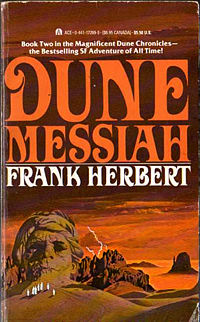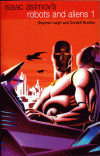
Frank Herbert continues his epic saga with Dune Messiah. Paul “Muad’Dib” Atreides has been Emperor for 12 years following the ending of the first novel when he took over. He has become a god figure, messiah, to the Fremen, which have ravaged the galaxy spreading their religion to countless worlds. Paul has not been able to prevent the jihad, but has been able to control it in a way.
I never wanted to be a god, he thought. I wanted only to disappear like a jewel of trace dew caught in the morning. I wanted to escape the angles and the damned—alone … as though by an oversight.
Princess Irulan continues to compile her histories, denied the physical attention of Paul. Chani and Paul have tried to conceive and heir, but have yet to be successful. It turns out that Irulan has been slipping a contraceptive into Chani’s food, hoping that Paul will give up and produce an heir with herself.
There is a conspiracy involving the Reverend Mother Gaius Helen Mohiam, Princess Irulan, a Tleilaxu Face Dancer of the Bene Tleilax (which has the ability to perfectly mimic the appearance, voice, and demeanor of others) named Scytale, and a guild navigator named Edric. They hope to destroy Paul and take back control of Dune and the spice trade. The reason they can conspire against Paul is that he cannot foresee events which involve guild navigators. They create a type of interference which Paul cannot penetrate with his skills as the kwisatz haderach.
An interesting trait of Scytale, as with all Tleilaxu, is that he is willing to help destroy Paul, but only if there is a chance of escape. The tool which they will use to destroy Paul is a ghola (essentially an advanced clone), grown from the remains of Duncan Idaho. This is a being with the mannerisms, skills, and demeanor of the old Duncan, but without his memories. The man, called Hayt, is presented as a gift to Paul by Edric. Paul could refuse the gift, but that would be very poor form in the realm of politics.
Paul accepts Hayt, with reservation, perceiving some sort of trickery. He asks Hayt if he is meant to destroy Paul, which he confirms. Paul, however, keeps Hayt by his side. This reminds me of the saying, “Keep your friends close, but your enemies closer.” Although Hayt knows that he is meant to destroy Paul, he’s unaware of the specific circumstances.
Hayt ends up being one of my favorite characters in this book. Those he interacts with are constantly comparing him to the original Duncan Idaho, prompting Hayt to question his own existence and purpose. One significant difference between Hayt and Duncan is that Hayt has been trained as a mentat and in Zensunni philosophy. Hayt/Duncan plays a pivotal role, constantly trying to ascertain how he will be used to destroy Paul. He truly has no desire to hurt Paul, and begs to be sent away.
Paul knows that he must pay a high price to end the jihad, as seen through one of his prescient visions. Throughout the novel Paul struggles with deciding whether or not he is willing to pay that price. The specific price is known to Paul, but not revealed to the reader. What is most interesting is how Frank Herbert unveils the scope of Paul’s power. Visions of the future and past converge, branching out into countless possibilities. Paul’s goal is to force events to follow the one path which will end the jihad.
Little stumbles here and there suggest that Paul isn’t as omnipotent as he hopes to be. Subtle differences pop up not quite matching his visions, then suddenly it seems that he locks on to the future he was searching for. Paul is a reluctant messiah, but the powers that he exhibits after this revelation only reinforce his god-like status with the Fremen.
From then on we see Paul bravely following the path he has foreseen to his own destruction. There are plenty of twists and turns, many of which caught me by surprise. Technology seems to be much more prevalent in this book, compared to the first one. The complex interactions are still there, with the welcome addition of the interesting Bene Tleilax. The pacing is much more consistent, with the entire events of the novel taking place at one after another, rather than over three distinct sections as in the first novel. Overall, I was very pleased with this sequel, and if anything, like it better than the original.

